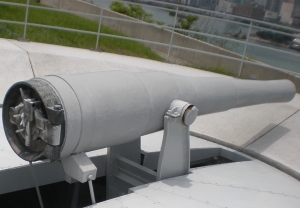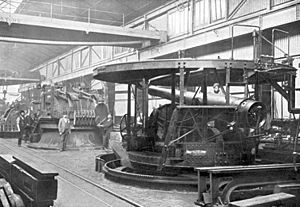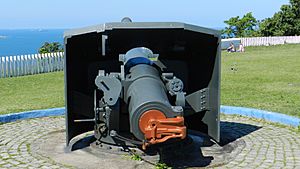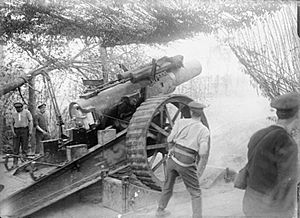BL 6-inch Mk II – VI naval gun facts for kids
Quick facts for kids Ordnance BL 6-inch gun Mks II, III, IV, VI |
|
|---|---|

Mk IV gun on disappearing carriage at Lei Yue Mun Fort, Hong Kong
|
|
| Type | Naval gun Coast defence gun |
| Place of origin | United Kingdom |
| Service history | |
| In service | 1880 – 1905 |
| Used by | Royal Navy |
| Production history | |
| Designer | Royal Gun Factory (RGF) |
| Manufacturer | RGF and EOC |
| Variants | Mks II, III, IV, VI |
| Specifications | |
| Mass | Mk II : 81 cwt or 89 cwt (4½ tons) Mks III, IV, VI : 5 tons barrel & breech |
| Barrel length | Mk III : 153.2 inches (3,891 mm) (25.53 calibres) Mk IV, VI : 156 inches (3,962 mm) (26 calibres) |
|
|
|
| Shell | 100 pounds (45.36 kg) |
| Calibre | 6-inch (152.4 mm) |
| Breech | 3 motion interrupted screw. De Bange obturation. |
| Muzzle velocity | Mk III, IV, VI : 1,960 feet per second (597 m/s) QFC guns : 1,913 feet per second (583 m/s) BLC guns : 2,166 feet per second (660 m/s) |
| Maximum firing range | 10,000 yards (9,100 m) |
The BL 6-inch gun Marks II, III, IV and VI were powerful naval guns used by the British in the late 1800s. These guns were designed by the Royal Gun Factory. They were an improved version of earlier 6-inch guns.
These guns were first made to use gunpowder as a propellant. Later, they were updated to use a newer, more powerful propellant called cordite. From 1891, newer warships started using a different type of 6-inch gun, but these older models were still very important.
Contents
How the Guns Were Developed
These guns were designed by the Royal Gun Factory. However, another company, Elswick Ordnance, also helped make them.
Mark II Gun: Early Design
The Mark II gun was an improvement over the very first 6-inch gun. It was designed to fire a heavier, 100-pound projectile. This size of projectile became standard for British 6-inch guns for many years.
The first Mark II guns were made with a thick steel barrel and iron jackets. They weighed about 4½ tons. However, these guns were not strong enough. Extra steel hoops were added to make them stronger. The gun was also made a bit shorter to balance it better.
Sadly, a Mark II gun burst on a ship called HMS Cordelia in 1891. After this accident, these specific guns were mostly used for training and not for firing.
Marks III, IV, and VI Guns
The Mark III gun was a big step forward because it was made entirely of steel. This made it much stronger. Even so, the first Mark III guns still used weaker charges. Most of them were strengthened with more hoops. This allowed them to use a full powder charge and fire projectiles at a faster speed. This made the gun weigh about 5 tons.
The Mark IV gun included all the improvements made to the Mark III. The Mark VI gun was very similar to the Mark IV, but it was a bit simpler to build.
The Mark III, IV, and VI guns were the most common versions. They were considered very successful and performed the same way. These guns were used on many British warships, including battleships and cruisers, in the late 1800s.
QFC: Quick-Firing Conversion
Many Mark IV and VI guns were used to defend coasts around the British Empire. They were placed on special mounts that could hide the gun after it fired, or on slides that absorbed the gun's kickback.
From 1895, many of these guns were changed to be "quick-firing" (QF). This meant they could use the same brass cartridge cases as newer, modern 6-inch guns. These converted guns were called QFC (QF Converted). They were given new names like I/IV (meaning the first version of a Mark IV gun converted to QFC).
BLC: Coast Defence Gun
Some Mark IV and VI guns were updated in 1902. Their old firing mechanisms were replaced with newer, simpler ones. The part of the gun where the cartridge goes was also made longer. This allowed them to use a more powerful cartridge. These guns were called BLC (breech-loading converted) coast defence guns. They could fire a projectile up to 12,000 yards (about 11,000 meters). These guns were later replaced by even more modern guns and were considered old-fashioned by 1922.
BLC: Siege Gun for Land Battles
In 1902, some Mark IV and VI BLC guns were also set up to be moved around. They could be transported in parts as "siege guns." A siege gun is a large gun used to attack forts or cities. The gun and its platform were moved separately. They were then put together at the firing location.
When World War I started in 1914, two groups of these BLC siege guns were sent to France. They were put on simple wheeled carriages and pulled by steam engines. These guns had a limited recoil system, meaning they needed blocks placed in front and behind their wheels when they fired. They could shoot up to 14,200 yards (about 13,000 meters). However, they were soon replaced by more modern guns in 1915. After that, they were changed into 8-inch howitzers.
World War I: Converted to Howitzers
At the start of World War I, Britain desperately needed heavy artillery for land battles. In 1915, many old BL 6-inch naval guns were shortened and made wider to become BL 8-inch howitzers. A howitzer is a type of artillery that fires shells in a high arc.
For example:
- 12 BLC Mark I/IV guns became 8-inch howitzer Mark I.
- 6 BL Mark IV and VI guns became 8-inch Howitzer Mark II.
- Other Mark IV and VI guns were also converted into howitzers for different types of carriages.
Image gallery
See also
- List of naval guns
Similar Weapons
- 6"/30 caliber gun - A similar gun used by the United States.
Where to See Them Today
You can still see some of these historic guns:
- Three guns at Green Hill Fort, Thursday Island, Australia: A Mark IV gun (No 727, from 1890) and two Mark VI guns (Nos 838 & 839, from 1892).
- A Mark IV gun on a disappearing carriage at Lei Yue Mun Fort, Hong Kong.
- A Mark IV gun (No. 726, from 1890) at Princess Royal Fortress, Albany, Western Australia.








